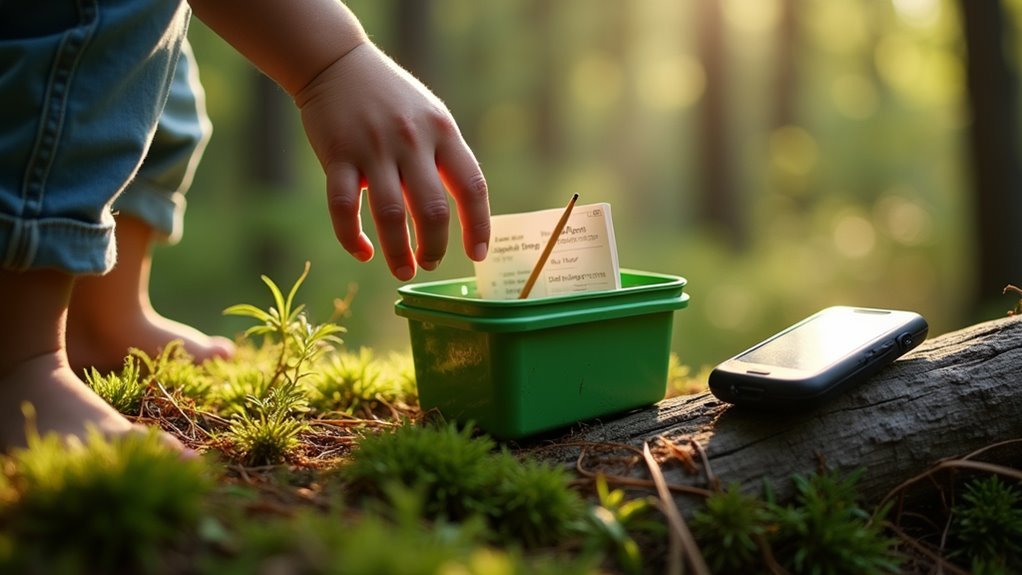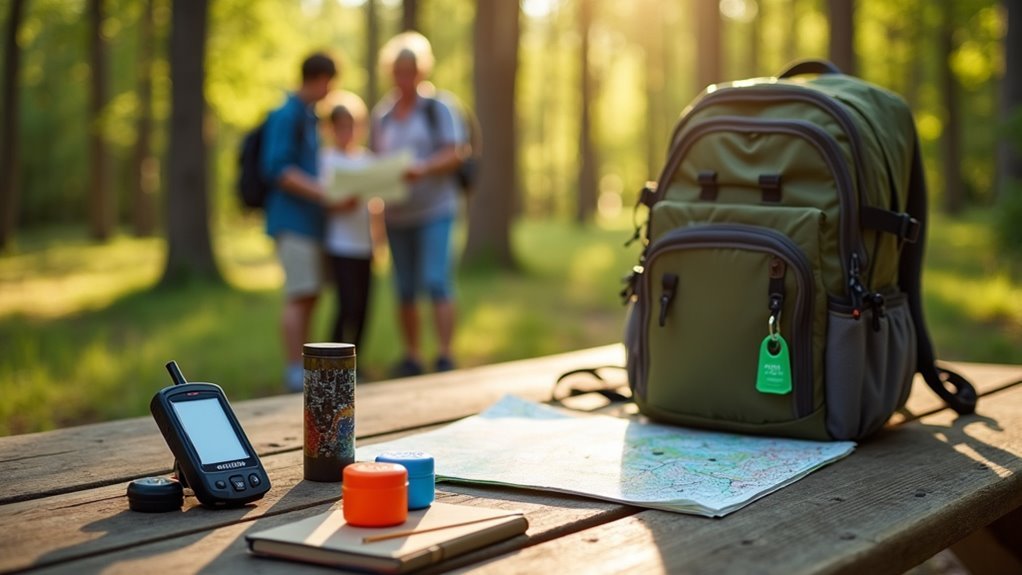Some of the links in this article may be affiliate links. If you make a purchase through these links, we may earn a small commission at no extra cost to you. Thank you.
Did you know that over 3 million geocaches are hidden worldwide, with thousands perfect for beginners? I’ve been taking my kids geocaching for years, and I’ve learned that starting with the right cache can make or break a family’s experience. Traditional caches in local parks are where you’ll want to begin—they’re accessible, straightforward, and usually contain trinkets that kids absolutely love. In my next section, I’ll show you exactly what makes certain caches ideal for first-timers.
What Makes a Geocache Perfect for Beginners

What makes a geocache beginner-friendly?
In my experience, it’s all about the difficulty and terrain ratings.
I always recommend looking for caches with a 1 or 1.5 difficulty – they’re genuinely easy to find and perfect when geocaching with kids.
When starting geocaching, focus on those 1-1.5 difficulty caches – they’re perfect confidence builders for newcomers and young adventurers!
Larger caches are also ideal for beginners since they’re easier to spot than those tiny micro containers that can frustrate newcomers.
When you’re just starting your geocaching journey, stick to traditional cache types in local parks rather than puzzles or multi-caches.
Well, think of it like learning to swim – you don’t start in the deep end!
Start with easy finds to build confidence.
The Beginners Guide to success? Choose accessible locations, manageable terrain, and straightforward hides that’ll leave everyone feeling accomplished rather than frustrated.
Traditional Caches: The Ideal Starting Point
The classic traditional cache is, without a doubt, the perfect gateway into the world of geocaching for families with young adventurers.
I’ve found these simple treasure hunts require nothing more than following GPS coordinates to locate hidden containers – no complicated puzzles or special skills needed!
When you start geocaching with kids, traditional caches are ideal because they’re typically rated easy (usually 1-1.5 difficulty), making the find achievable and confidence-building.
Your little ones will love the excitement of discovering the container and getting to sign the log with their name.
The best part? Many traditional caches contain trade items – small trinkets that kids can swap.
It’s like, um, a little reward system that makes each find extra special!
With millions available in parks and trails, you’ll easily find one near you today.
Urban Park Caches: Accessible Adventures

Urban park caches represent, in my experience, one of the most family-friendly entry points to geocaching you’ll ever find.
Urban park caches offer families the perfect gateway into geocaching adventures—accessible, abundant, and delightfully straightforward for newcomers.
They’re practically everywhere—millions worldwide according to Geocaching.com—and my kids loved how easy they were to access via regular walking paths.
What makes these perfect for beginners?
Well, they typically have a low difficulty rating (1 or 1.5), so you’re not struggling to find them.
The free Geocaching app guides you within 30 feet of the cache with its compass feature—super helpful when you’ve got impatient little ones!
I think what makes this outdoor activity special is finding those traditional containers with trinkets for trade.
My 5-year-old actually couldn’t wait to swap her toy dinosaur for a marble last weekend.
It’s simple family fun in familiar settings.
Earth Caches: Educational Outdoor Discoveries
I’ve found Earth Caches to be the perfect family learning adventures, combining our love for the outdoors with fascinating geology lessons right beneath our feet.
When my kids touch ancient rock formations or identify erosion patterns, they’re connecting with science in ways that textbooks simply can’t match.
You’ll love watching your children transform into curious scientists as they answer questions about the natural landmarks you’re visiting, creating memories while building knowledge that sticks.
Educational Benefits Unveiled
How often have you turned a family hike into a geological adventure? Earth Caches offer this exact opportunity! I’ve found they’re my favorite way to blend outdoor adventure with real education about the natural world.
When you’re using the Geocaching app to find Earth Caches, you’re not just logging your find—you’re answering questions about rock formations or erosion that spark curiosity.
I think they’re the perfect guide to geocaching for families because they teach mapping skills and coordinates while building a sense of adventure.
They’ve been around since shortly after geocaching began in 2000, and they’re great for learning about the history of your area. Plus, many incorporate CITO principles—Cache In, Trash Out—teaching environmental stewardship that, well, we honestly need more of these days.
Geology Lessons Outdoors
When you’re standing at the edge of a canyon with your kids, have you ever thought about the millions of years of history beneath your feet? That’s exactly what Earth Caches offer—geology lessons disguised as outdoor activities! Unlike traditional geocaches hidden in containers, Earth Caches invite participants to navigate to specific geological sites and learn through observation.
I think these are perfect for families just starting to explore geocaching.
You don’t need to find the geocache physically; instead, you’ll answer questions about what you see.
With over 20,000 worldwide, they’re a great way to start exploring new parks while actually learning something.
Most are beginner-friendly with low difficulty ratings, so your geocaching adventure becomes educational too!
My family particularly loves how they’ve helped us discover amazing formations we’d probably have driven right past.
Family Learning Adventures
Why do Earth Caches make such fantastic family learning adventures?
Unlike traditional outdoor treasure hunting, these special geocache hunts don’t require physical containers, making them perfect for families committed to Leave No Trace principles.
I’ve found that when I started geocaching with my kids, Earth Caches offered the thrill of the hunt while sneaking in geology lessons almost anywhere we went.
You’ll need a GPS device or smartphone, but what you’re really collecting is knowledge!
Instead of trinkets, you’re gathering experiences as your family answers questions about rock formations or erosion patterns.
In my experience, kids don’t even realize they’re learning—they’re too busy exploring!
Plus, many Earth Caches complement CITO (Cache In Trash Out) events, teaching environmental stewardship alongside scientific discovery.
Simple Mystery Caches for Young Puzzle Solvers
I’ve found that backyard riddles and schoolyard mystery caches are perfect starting points for kids who’re dipping their toes into geocaching.
These simple puzzles, usually rated under 2 stars, give my daughter a chance to feel like a real detective while we’re out exploring our neighborhood parks.
When you’re looking for family-friendly options, these mystery caches with themes like animal adventures or hidden treasures will have your young ones begging to solve “just one more” before heading home.
Decoding Backyard Riddles
How do you take the mystery out of mystery caches while keeping all the fun intact? I’ve found that backyard riddles are the perfect way to introduce little ones to geocaching with little pressure. Before you attempt to find a cache in unfamiliar territory, start with simple coordinates and then attempt some puzzles right at home.
| Riddle Type | Age Range | Skills Developed |
|---|---|---|
| Object Hunt | 5-7 years | Observation |
| Word Puzzles | 7-8 years | Reading |
| Simple Math | 8-10 years | Problem-solving |
Always check the difficulty rating (aim for 1-1.5) and follow directions on the cache page. When you find one, celebrate! The geocache (container) hidden isn’t the only reward—it’s seeing their little bit of confidence grow with each discovery.
Schoolyard Mystery Favorites
Curiosity transforms ordinary schoolyards into thrilling adventure zones when you’re hunting for mystery caches with your young ones. I’ve found these simple puzzles are perfect for first-time geocachers, with most families able to find them without frustration – they’re typically rated just 1-1.5 stars for difficulty.
What I love is how kids spend time solving riddles that lead to film canisters tucked under benches or near playground equipment.
They’ll have such a good time recording their date of discovery in the logbook!
The geocaching community often designs these with educational elements about local history, which beats classroom learning any day.
Plus, many include CITO reminders (Cache In, Trash Out), teaching environmental responsibility while having fun.
In my experience, there’s nothing better than watching a child’s face light up when they crack their first schoolyard mystery!
Geocaching Gear for Family Expeditions

Successful family geocaching adventures require five essential gear items that’ll transform your hunt from frustrating to fantastic.
First, you’ll need a smart phone with the geocaching app downloaded.
It guides you within 30 feet of treasure—much better than wandering aimlessly through poison ivy on a long hike!
Don’t forget a pen and paper for logbook signing.
I always pack trinkets of equal or greater value from dollar stores so my kids can take an item and leave something cool.
Sometimes we even find a Travel Bug to move along!
Comfort matters too—sturdy shoes, bug spray, and sunscreen are non-negotiable in my experience.
Finally, pack water, snacks, a compass, and flashlight.
We practice a little CITO (Cache In, Trash Out) while we’re at it!
Navigation Tips for First-Time Cache Hunters
Where do you even start when your phone says the treasure is “somewhere around here”?
I’ve been there!
During our last Road Trip, this treasure hunting game led us to some confusing moments.
Standing in a random parking lot, phone in hand, wondering if we were hunting treasure or just looking foolish.
Let me help make sure your first attempt to find a cache isn’t your last.
When starting out, use the app’s map and compass features – that red line has saved me countless times!
The app will get you within about 30 feet, then it’s detective time.
Look around us for suspicious piles of stones or hollow logs, depending on the size of the cache.
Start with caches rated 1.5 or below in difficulty – trust me, there’s no shame in easy wins when you’re learning!
And always check real landmarks as you navigate from cache to cache.
Building Confidence: From Neighborhood Finds to Trail Adventures
The first successful hunt has a way of lighting that geocaching spark that can turn into a lasting family hobby.
I always recommend starting with neighborhood finds rated 1.0-1.5 difficulty.
These beginner caches build family confidence through quick wins close to home.
Once you’ve mastered nearby hunts, it’s time to level up!
Use the geocaching app to filter for traditional caches with low difficulty and terrain ratings in local parks.
These might be tucked under logs or behind rocks—not too challenging but just tricky enough to feel rewarding.
Progress tracking is key to staying motivated.
After logging several neighborhood successes, try venturing onto short trails.
I’ve found that children especially love this natural progression from sidewalks to trail adventures, where each find feels like a bigger accomplishment.
Frequently Asked Questions
What Is the Best Geocache App for Beginners?
I’d recommend the official Geocaching app for its beginner-friendly interface design. Its feature highlights include green dots for easy caches, compass view, and regular updates. Support options are excellent with good battery integration.
How to Start Geocaching for Beginners?
I’d recommend starting on this treasure-seeking adventure by downloading the Geocaching app, gathering basic equipment, and choosing family-friendly terrain. Start with safety precautions, develop navigation skills, and practice logging techniques before joining the community or hiding caches yourself.
Is Geocaching Still a Thing in 2025?
I’m seeing geocaching’s future popularity soar in 2025, with impressive community growth and modern appeal through tech integration. Global participation continues expanding, creating positive sustainability impact through outdoor activity revival.
What Geocache Has the Most Finds?
Like a lighthouse guiding adventurers, the original cache in Beavercreek, Oregon holds the crown among find champions. I’ve tracked cache records showing it’s broken global highs with over 100,000 logged visits since 2000.